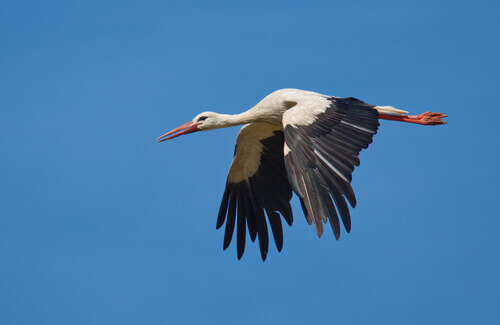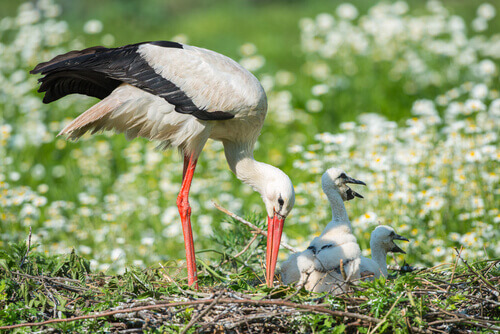White Stork Migration: Interesting Facts About These Birds


Written and verified by the biologist Samuel Sanchez
The migration of the white stork (Ciconia ciconia) has changed over time. For example, most of them flew thousands of miles each year after breeding. During white stork migration, these birds spent almost a month crossing half of Europe, the Strait of Gibraltar, and the Sahara desert.
If these birds survived this difficult journey, they would spend the winter in sub-Saharan Africa countries, such as Mali, Niger, or Chad. They stayed here from September until the beginning of February and then returned to Europe.
Regarding this migration, there’s a Spanish saying which says that “You will see storks on Saint Blaise day,” which is February 3rd.
White stork migration: An amazing migratory bird
However, not all birds completed this journey. This journey was very difficult and long, and many specimens perished during migration. To avoid crossing the Mediterranean, where the warm updrafts that storks use to maintain long-lasting flight don’t form, storks followed two migration routes:
- One option is crossing the Bosphorus and Dardanelles straits through the Balkans and Turkey.
- Another option is crossing the Strait of Gibraltar through the Iberian Peninsula.
As a result of the last route, there are many storks in Spain. However, for decades, white stork migration patterns have changed. We’ll explain how below.

White stork migration isn’t like it was before
For decades, many experts have observed that white stork migration has changed. Many spend the winter in their breeding areas.
This is due in part to the increase in temperatures that causes more mild winters on the peninsular. Also, storks now are able to find food throughout the year due to the presence of landfills.
There are also many lagoons and wet areas on the Peninsula where they can spend the winter and find food. For example, there are the Tablas de Daimiel in Ciudad Real or the Laguna del Campillo in Rivas Vaciamadrid.
Migration yes, but shorter
However, this doesn’t mean that white storks don’t migrate at all. According to an SEO/BirdLife study, many storks nest in rural areas in Spain. Then, when winter arrives, they move to the outskirts of cities, such as Madrid. There, they find food in the Valdemingómez landfill, which is one of the largest in Europe.
This study was verified by radio transmitters that researchers placed on a couple of storks, Goyo and Enara. These birds migrated in August, heading south from Madrid from the mountains.
This change in their migratory habits seems positive for the survival of the species. By saving themselves from such a long, dangerous journey, more and more storks survive. Also, they have continuous availability of food, which helps with survival.
Young storks keep migrating
Another interesting aspect of the SEO/BirdLife study is the difference between adult storks and young storks. These researchers found that young storks continue to migrate. They make the dangerous journey to Africa, while adults remain in Europe during the winter.

Moreover, according to the same study, many birds from colder parts of Europe migrate to Spain to spend the winter.
As a result, the number of storks in Spain in the winter is increasing substantially: for those that don’t go to Africa in the winter and for those that come from Northern Europe.
Migratory routes in detail
The Spanish Ornithological Society, in collaboration with other European organizations, has spent years studying the white stork migration. They recently published a detailed study where they included data from GPS radio transmitters on migratory storks for the first time. The results were varied:
- First, they confirmed the hypothesis that young storks migrated to the Sahel, while adult storks wintered in Spain.
- Central European storks, of which the majority spent the winter in Spain, had a greater survival rate (around 50%) than Spanish storks that migrated to Africa. Of the latter, only 1 in 10 returned to their breeding place.
- Meanwhile, adult storks wintered mostly in Europe. This helped the vast majority survive the following year.
In conclusion, the migratory behavior of the stork and this change is crucial. In fact, it likely predicts a general change for many migratory birds.
However, while it seems that their lack of migration has a positive effect on their survival, it remains to be seen how climate change will affect these birds.
All cited sources were thoroughly reviewed by our team to ensure their quality, reliability, currency, and validity. The bibliography of this article was considered reliable and of academic or scientific accuracy.
Bécares, J.; Blas, J.; López-López, P.; Schulz, H.; Torres-Medina, F.; Flack, A.; Enggist, P.; Höfle, U.; Bermejo, A. y De la Puente, J. 2019. Migración y ecología espacial de la cigüeña blanca en España. Monografía n.º 5 del programa Migra. SEO/BirdLife. Madrid. https://doi.org/10.31170/0071.
This text is provided for informational purposes only and does not replace consultation with a professional. If in doubt, consult your specialist.